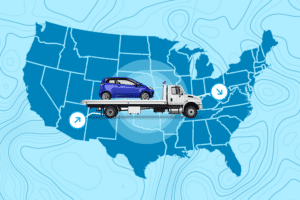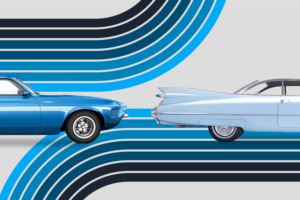Airbnb and other vacation rental platforms have fundamentally changed how we travel. Today, we’re no longer stuck paying big hotel-chain prices or sorting through online booking sites in search of so-called deals.
Instead, Airbnb, VRBO, and HomeAway sit squarely between supply and demand, centralizing and opening up a vast inventory of extra rooms, houses, and apartments we never knew existed. It’s not uncommon that vacation rentals sites are the FIRST place we look when traveling to a destination for work or pleasure.
No doubt, this has been the topic of endless heated debate in corporate hotel chain board rooms for over 10 years now.
Meanwhile, the trucking and logistics industry is coming off the perfect storm that was 2018. Manufacturing and e-commerce filled trucks at record rates and velocity.
Legislation reduced truckers’ hours behind the wheel, all while the industry continues to face an apparent truck driver shortage. Trucking lobbyist group American Trucking Association says the shortage surpassed 50,000 in 2017 and continues to get worse without proper recruiting efforts.
At the same time, the U.S. Department of Labor disagrees with the ATA’s driver shortage position. A newly-published report now refutes the long-held belief, claiming there’s never been a driver shortage — and there’s not one now. The Bureau of Labor Statistic’s report says, to no one’s surprise, that there’s less attrition and higher retention when there are increased wages, something trucking organizations have been arguing for years.
THE CHANGING FACE OF TRUCKING
What neither side has acknowledged or accounted for, at least not in their recent reports, is how the face of trucking is changing — and this is where the paths of logistics and hospitality converge in ways you may have never known.
Just as Airbnb inspired the notion of utilizing non-traditional, underutilized rooms, tiny houses, and condos, the same model is inspiring a new type of trucker in America. And if there is indeed a driver shortage, the model is helping stem the tide by putting new drivers behind the wheel.
Today those new types of non-traditional drivers number in the tens of thousands on our nation’s highways. They are not driving huge 18-wheelers we commonly associate with trucking. Instead, they operate underutilized truck space. They are drivers of 22-foot sprinter cargo vans, 20-foot box trucks, and Ford F-350 Super Duty pickup trucks with 14-foot enclosed or three-car wedge trailers attached.
Also, just as there are no two Airbnbs alike, the one thing these drivers all have in common is that they are all different.
They are small business owners. They are husband and wife teams. They are solo drivers. They are dads and moms with sons and daughters along for the ride, seeing the country.
Some have been hot shot drivers for decades; others have been in this logistics job just a few short years. Some have stumbled across the opportunity to experience the open road and earn a living outside the confines of an office.
Some have become popular reality TV stars. Some drive nationwide, others regionally or consistently on a particular lane or Interstate that’s most relevant and lucrative to them. Others specialize in last-minute shipping.
They haul vehicles new and old, motorcycles big and small, and boats wide and tall. They deliver vintage furniture, maritime antiques, arcade games, classic vending machines, pool tables, Vespas, wildlife taxidermy, life-size Frank Sinatra statues, Mad Men set props, vans once owned by Jerry Seinfeld, and dismantled commercial airliners, to name a few.
Much of this can be referred to as non-traditional freight – stuff that doesn’t stack nice and tight in a large trailer. However, it’s profitable freight. To these drivers, there’s no shortage, just opportunity. This is their chance to pick and choose what they’d like to haul on uShip, the site that centralizes this very fragmented set of transporters. In 2018, uShip had 41,000 active carriers.
Let’s look at the benefits of this non-traditional set of drivers and how they are helping change the industry.
REDUCED OVERHEAD
uShip has spoken with many drivers that tell us they have traded in big-rig fleets for a smaller footprint. A logistical downsizing. Fewer headaches. Fewer expenses. Fewer parking hassles. They now drive the sprinter vans, box trucks, and pickup-trailer combinations.
Trucker trade journal Overdrive Magazine also featured this phenomenon in a recent cover story, talking to many former Class 8 big rig drivers who found relief in better gas mileage, more nights at home, and greater flexibility when it comes to regulations.
Another factor around carrier downsizing is repairs. When you’re out on the road, inevitably there’s going to be a need for a mechanic or parts to keep you moving. Let’s face it, it’s far easier finding an auto parts store or tire shop that’s open on weekends or evenings than it is a semi-truck mechanic.
While it’s true they may have less capacity than a full-size 53’ dry van, they make it work economically by finding anchor loads, say a large antique chest going cross-country, and then find shipments to go around it, so they are always running with a full truck and trailer.
A great example of this is Jerry Bortez of BCC Trucking, who previously owned a fleet of three semi-trucks. Today, he drives a pickup with a trailer.
Another is DeAndre Ingram of King Shipping. He was between jobs when an interior designer gave him a shipping contract. He’s since turned that into a much larger business. Now he has two teams driving truck-trailer combinations.
REGIONAL TRANSPORT
This one is a biggie. Many truckers spend over 300 days a year on the road. Not exactly a scintillating recruiting point as the industry is looking to backfill an aging driver population with new drivers who are also getting lured by home-at-night jobs like manufacturing and construction.
Those driving smaller vehicles still can roam the country with the best of them, but there are also exists the option to haul closer to home, or within one’s region, to be able to spend more home-time if desired.
Melissa and Dustin Derma of Derma Transport have done over 700 shipments on uShip since 2011
Take, for example, Dustin and Melissa Derma of Derma Transport. The husband and wife team haul motorcycles, furniture, and even horse-drawn carriages up and down the West Coast. While they hold a residence in Port Angeles, Wash., on the Olympic Peninsula, they also tend the family’s almond farm in the Central Valley of California, near Stockton.
Picking up a few shipments was initially intended to cover expenses of the back-and-forth drive, but today it’s a full-blown business with well over 700 bookings. Melissa finds, quotes, and books the shipments, and communicates with the customers, while Dustin oversees the driving and deliveries.
REPUTATION
As a leased owner-operator or company driver, drivers are at the whim of dispatchers. Those drivers likely have no idea what’s in the trailer behind them, and their reputation is only as good as the most recent delivery.
When it comes to non-traditional carriers, they control their destiny from a reputation perspective. Through a feedback system similar to Airbnb’s, carriers’ feedback scores on uShip let people and businesses make informed decisions about with whom to work because they can see the good, the bad, and the amazing of real reviews by real customers.
That positive feedback score is something transporters on uShip hold sacred given how important it is to booking new business. It’s survival of the fittest at its best.
For example, the earlier referenced carrier DeAndre Ingram has built his reputation on uShip since 2013 and through more than 1700 shipments. He maintains a near 1,000 feedback score and 99 percent positive feedback — numbers that would make any Airbnb host proud.
Elizabeth Orton, owner, Find-a-Way Shipping
There’s Elizabeth Orton, a 20-something former Division I basketball player. She and her cousin started Find a Way Shipping in the summer of 2018. She’s expanded her fleet fourfold in the six months since. She’s built her business on exceptional customer service on top-notch customer reviews, plus and an impressive feedback score.
CONCLUSION
When you combine reduced overhead, closer-to-home operations, and reputation building with all the available tech tools — applications, tracking, payments, booking, and more — it’s a good time to be a non-traditional carrier.




